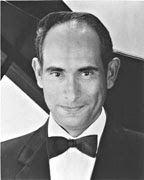BIOGRAPHY
One of Southern California's leading pianists, Charles Fierro has made concert tours for the National Endowment for the Arts and the California Arts Council and has given more then 25 concerto performances with orchestras. He has appeared twice at the National Gallery of Art and the Dumbarton Oaks Foundation in Washington, D.C. In 1976 he played the American Bicentennial Recital at the Palace of Fontainebleau in France on the personal invitation of the legendary musician, Nadia Boulanger. He has interpreted the music of Beethoven, Schumann and Liszt at the Ojai Festivals and performed more than a dozen times at the prestigious Monday Evening Concerts in Los Angeles, presenting the American premieres of important new works.
His debut for Nonesuch Records was named “Critics’ Choice” for five consecutive months by High Fidelity Magazine. His recording of the piano music of Aaron Copland was made under the auspices of the composer himself. For Delos International, he has recorded MacDowell's Sonata Eroica and Twelve Virtuoso Etudes. For Nonesuch, he has recorded MacDowell's Keltic Sonata, Sea Pieces, and Woodland Sketches and the world premiere recording of MacDowell's First Modern Suite. Current plans include recordings of Hindemith's Three Piano Sonatas and Ludus Tonalis.
As Professor of Music at California State University Northridge, he received the Distinguished Teaching Award. An experienced adjudicator, he is known for his inspiring master classes in all aspects of the piano repertory. He has lectured at the New England Conservatory in Boston, taught at the Image International Music Festival and served on the Board of Directors of the Paderewski Music Society. He is also the author of numerous published articles on musical subjects, as well as chamber music reviews which have appeared in the international press.
Charles Fierro studied piano with Lillian Steuber, Adele Marcus and Joanna Graudan and musicology and conducting with composer Ingolf Dahl, whose major piano works he has recorded on the Orion label. He holds a Doctorate of Music “with Distinction” from the University of Southern California.
One of Southern California's leading pianists, Charles Fierro has made concert tours for the National Endowment for the Arts and the California Arts Council and has given more then 25 concerto performances with orchestras. He has appeared twice at the National Gallery of Art and the Dumbarton Oaks Foundation in Washington, D.C. In 1976 he played the American Bicentennial Recital at the Palace of Fontainebleau in France on the personal invitation of the legendary musician, Nadia Boulanger. He has interpreted the music of Beethoven, Schumann and Liszt at the Ojai Festivals and performed more than a dozen times at the prestigious Monday Evening Concerts in Los Angeles, presenting the American premieres of important new works.
His debut for Nonesuch Records was named “Critics’ Choice” for five consecutive months by High Fidelity Magazine. His recording of the piano music of Aaron Copland was made under the auspices of the composer himself. For Delos International, he has recorded MacDowell's Sonata Eroica and Twelve Virtuoso Etudes. For Nonesuch, he has recorded MacDowell's Keltic Sonata, Sea Pieces, and Woodland Sketches and the world premiere recording of MacDowell's First Modern Suite. Current plans include recordings of Hindemith's Three Piano Sonatas and Ludus Tonalis.
As Professor of Music at California State University Northridge, he received the Distinguished Teaching Award. An experienced adjudicator, he is known for his inspiring master classes in all aspects of the piano repertory. He has lectured at the New England Conservatory in Boston, taught at the Image International Music Festival and served on the Board of Directors of the Paderewski Music Society. He is also the author of numerous published articles on musical subjects, as well as chamber music reviews which have appeared in the international press.
Charles Fierro studied piano with Lillian Steuber, Adele Marcus and Joanna Graudan and musicology and conducting with composer Ingolf Dahl, whose major piano works he has recorded on the Orion label. He holds a Doctorate of Music “with Distinction” from the University of Southern California.
